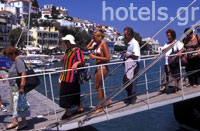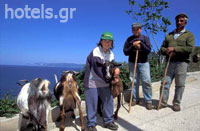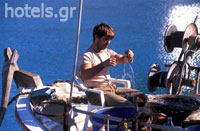|
Economy of the Island
 Tourism
Tourism
Tourism constitutes the main source of income for the island of Skopelos. The island has about 50,000 visitors each year. The tourist period begins in May and ends in October with a peak period between 1/7 and 15/9.
The growth of tourism was at the expense of agriculture and livestock-farming. The first hotel that operated on the island was The Skopelos in 1930 and owned by Prodromou Kathinioti. The hotel was open all year, during the summer for the few visitors and in the winter for the tradesmen, salesmen, school teachers and students who were studying in Skopelos High school from Glossa and Klima. This hotel was in the building that today accommodates the county court. There were seven rooms and two communal toilets with shower. The each room had three beds and a small water container with a tap for washing.
After the death of Prodromou Kathinioti, his wife Alexandra took over the running of the hotel until 1965 when earthquakes caused serious damage. It was rebuilt and became the County Court.
 Agriculture
Agriculture
With the growth of tourism on the island resulted in less residents being occupied with agriculture. The island produces: fresh and dry plums, olives, olive oil, wine and honey. Up to the beginning of the 20th century the vines were cultivated with Skopelos wine being renowned in Greece up to 1940, when a terrible epidemic of phylloxera destroyed the eminent vines of island. Residents then began to cultivate plums and olives. Today the main product is the olive, although the production has been decreased.
 Livestock
Livestock
From the 11th until the 14th century Skopelos was supported by livestock-farming. A high percentage of residents had their own animals that were sold, exchanged or used for their own needs (eg for food). Until the 12th century the limited variety was hens, pigs and goats.
After the 12th century livestock-farming grew during the Venetian rule and the variety increased in the 13th century. The Venetians brought new species, as ibexes, horses, ostriches, wild boars and cattle. Livestock-farming was the main employment of the residents until the 15th century. At this time began the first collaboration between the owners of animals, linking their flocks and thus achieve larger production, faster reproduction and naturally larger profits.
In the 17th century livestock-farming fell due to the lack of forage. The diseases that affected the animals forced even the rich cattle-breeders to abandon livestock-farming. Today livestock-farming is minimal. The livestock on the island is limited to a particular breed of goat and are protected from diseases by government veterinary care.
 Fishing
Fishing
Until the 19th century the fishing was the main occupation of Skopelos. After the 19th century fishing began to take secondary role. Most fishermen had small boats and threw their nets or their trawl line. After 1910 most islanders turned to agriculture, manufacture and mainly tourism in recent years. Today there are a few fishermen who supply fishmongers and tavernas.
|


